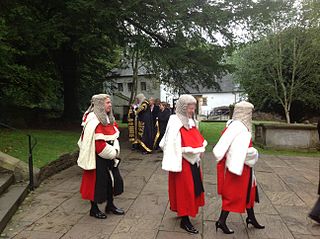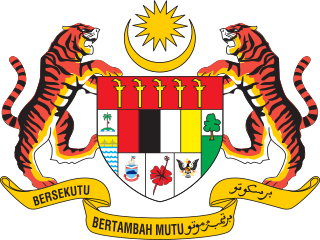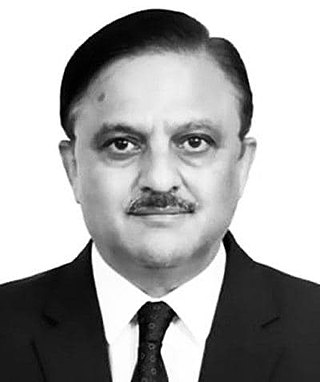Related Research Articles

The Supreme Court of India is the supreme judicial authority of India and is the highest court of the Republic of India under the constitution. It is the most senior constitutional court,has the final decision in all legal matters except for personal laws and interstate river disputes,and also has the power of judicial review. The Chief Justice of India is the Head and Chief Judge of the Supreme Court,which consists of a maximum of 34 judges,and has extensive powers in the form of original,appellate and advisory jurisdictions. New judges here are uniquely nominated by existing judges and other branches of government have neglible say as the court follows collegium system for appointments.

The High Court of Bombay is the high court of the states of Maharashtra and Goa in India,and the union territory of Dadra and Nagar Haveli and Daman and Diu. It is seated primarily at Mumbai,and is one of the oldest high courts in India. The High Court has regional branches at Nagpur and Aurangabad in Maharashtra and Panaji,the capital of Goa.

The chief justice of India is the chief judge of the Supreme Court of India as well as the highest-ranking officer of the Indian Judiciary. The Constitution of India grants power to the president of India to appoint,in consultation with the outgoing chief justice,the next chief justice,who will serve until they reach the age of sixty-five or are removed by impeachment. As per convention,the name suggested by the incumbent chief justice is almost always the next senior most judge in the Supreme Court.
The High Court of Delhi was established on 31 October 1966,through the Delhi High Court Act,1966,with four judges,Chief Justice K. S. Hegde,Justice I. D. Dua,Justice H. R. Khanna and Justice S. K. Kapur. The High Court currently has a sanctioned strength of 45 permanent judges and 15 additional judges.

The Supreme Court of the United Kingdom is the final court of appeal in the United Kingdom for all civil cases,and for criminal cases originating in England,Wales and Northern Ireland. As the United Kingdom’s highest appellate court for these matters,it hears cases of the greatest public or constitutional importance affecting the whole population.

The Supreme Court of New South Wales is the highest state court of the Australian State of New South Wales. It has unlimited jurisdiction within the state in civil matters,and hears the most serious criminal matters. Whilst the Supreme Court is the highest New South Wales court in the Australian court hierarchy,an appeal by special leave can be made to the High Court of Australia.

The High Court of the Hong Kong Special Administrative Region is a part of the legal system of Hong Kong. It consists of the Court of Appeal and the Court of First Instance;it deals with criminal and civil cases which have risen beyond the lower courts. It is a superior court of record of unlimited civil and criminal jurisdiction. It was named the Supreme Court before 1997. Though previously named the Supreme Court,this Court has long been the local equivalent to the Senior Courts of England and Wales and has never been vested with the power of final adjudication.

The High Court of Jammu &Kashmir and Ladakh is the common high court for union territories of Jammu and Kashmir and Ladakh. It was established as the High Court of Jammu and Kashmir on 26 March 1928 by the Maharaja of Jammu and Kashmir. The seat of the court shifts between the summer capital Srinagar and winter capital Jammu. The court has a sanctioned judge strength of 17,13 of whom are permanent judges,and 4 are additional judges. Since 13 October 2022,the chief justice of the court is Hon'ble Shri Justice Ali Mohammad Magrey.

The Supreme Court of Bangladesh is the highest court of law in Bangladesh. It is composed of the High Court Division and the Appellate Division,and was created by Part VI Chapter I of the Constitution of Bangladesh adopted in 1972. This is also the office of the Chief Justice,Appellate Division Justices,and High Court Division Justices of Bangladesh. As of December 2022,there are 9 Justices in Appellate Division and 92 Justices in High Court Division.

A Justice of the High Court,commonly known as a ‘High Court judge’,is a judge of the High Court of Justice of England and Wales,and represents the third highest level of judge in the courts of England and Wales. High Court judges are referred to as puisne judges. High Court Judges wear red and black robes.

The Chief Justice of Malaysia,also known as the chief justice of the Federal Court,is the office and title of the head of the Malaysian judiciary system. The title has been in use since 1994,and prior to this it was known as the lord president of the Federal Court. The chief justice is the head of the Federal Court,the apex court of Malaysia. It is the highest position in Malaysian judicial system followed by the president of the Court of Appeal of Malaysia,chief judge of Malaya,and the chief judge of Sabah and Sarawak.

Susan Mary Kiefel is the chief justice of Australia,in office since 30 January 2017. She has served on the High Court since 2007,having previously been a judge of the Supreme Court of Queensland and the Federal Court. Kiefel is the first woman to serve as Chief Justice.
Mohanty/Mahanty/Mahanti is a native Odia surname native to Odisha but is also used in neighbouring states of Odisha such as Andhra Pradesh,Chhattisgarh,Telangana and West Bengal because of migration.

The Chief Judge of Sabah and Sarawak,formerly the Chief Justice of Borneo,is the office and title of the head of the High Court of Sabah and Sarawak. The title has been in use since 24 June 1994,when the High Court of Sabah and Sarawak was renamed from the High Court of Borneo.

Tengku Maimun binti Tuan Mat is a Malaysian lawyer who has served as the 10th Chief Justice of Malaysia since May 2019. She is the first woman to ascend to the highest judicial office of the country.

Abhay Shreeniwas Oka is a judge of Supreme Court of India. He is former chief justice of Karnataka High Court and judge of the Bombay High Court.
Justice Devendra Kachhawaha is an Indian judge. He was the judge of the Rajasthan High Court till his superannuation in 2022. Presently,the Government of State of Rajasthan has appointed him as Chairman of State Consumer Disputes Redressal Commission for the State of Rajasthan. Earlier he has served as a District and Session Judge of various District and Session courts in Rajasthan. An order elevating 6 judicial officers as Judge of Rajasthan High Court was issued on 4 March 2020 in this regard. All the six judges so elevated were sworn in by Chief Justice Indrajit Mahanty in a simple ceremony held on 6 March 2020.
Tripura Lok Adalat or Tripura State Legal Services Authority(People's Court) is an statutory and autonomous body and an alternative dispute resolution mechanism used in the state of Tripura.The Tripura Lok Adalat Act is designed to provide constitutional protection guaranteed under Article 14 and 39-A of the Constitution of India,of “ACCESS TO JUSTICE FOR ALL”. It is a legal system to resolve pending cases at Panchayat or rural places,those in a pre-litigation stage in courts are resolved amicably. It is recognised as statutory authority under the Legal Services Authorities Act,1987 and the Lok Adalats award or decision are deemed to be civil court case and final and enforceable on both parties. Such an award is not appealable in any court of law in the absence of any provision. However,by approaching the court of appropriate jurisdiction,litigation can be initiated by any party in the suit if any of them are dissatisfied with the decision of the Lok Adalat.
References
- Singh, Chandeep (30 August 2019). "Indrajit mahanty resolution". Bar & Bench. Retrieved 30 August 2019.